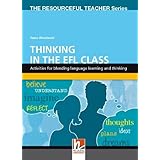
Thinking in the EFL Class by Tessa Woodward
Helbling Languages 2011
Today more than ever it’s vital that we get into the habit of thinking creatively, with empathy, and in a socially responsible way. I’m convinced that our survival as a human race depends on this. But even if you don’t share my view, you might agree that developing thinking skills and fostering attitudes which value autonomous and collaborative thinking are worthwhile educational aims.
Tessa Woodward’s Thinking in the EFL Class is an excellent resourcebook for guiding teachers in this area. Up until now if you were a teacher committed to ‘blending language learning and thinking’ in a systematic way, you had to do your own research outside the field of ELT. This book is a result of extensive research into diverse fields and tools such as Teacher Effectiveness Training, Exploratory Thinking, Questioning, Mindmapping, Critical Pedagogy, to mention a few. The book provides us with sound principles, helpful frameworks and – perhaps most important of all – 85 stimulating classroom activities.
It is organized around 7 Chapters which approach thinking from different angles, which is refreshing in itself. As the heading suggests, Fundamentals (Chapter 1) considers the main issues and challenges faced by teachers keen to adapt a thinking approach in their classrooms. It looks at basic questions such as: ‘Is it possible to teach ways of thinking?’ and ‘Does age make a difference?’ The accompanying activities focus on e.g. Waking-up, Calming-down, Moving into English, Ending a lesson well – in other words creating conditions that are optimal for each stage of the learning process. Other Chapters are about e.g. building concepts, looking for patterns, creative thinking, using everyday thinking frameworks.
My personal favourite is Chapter 3: Ways of structuring lessons for thinking. It contains helpful teaching tips and classroom activities that can lead to exploratory talk in our classrooms. For example, Inspiring people is a step-by-step description of a project that gets learners to think about people who have made a positive contribution to our world – and in so doing also explore ways in which they, too, can make a difference. The Chapter provides guidance to teachers who are keen to deepen the quality of classroom talk and to move from trivial conversation to real engagement with issues that matter.
I found activities in the book suitable for all levels – illustrating that a low level of English is not a barrier to being challenged to remember, think, speculate, imagine. I’ve learnt a lot from this publication and can recommend it wholeheartedly!
Margit Szesztay

No comments yet.